So here we are:
reigning champions in a major league professional sport. It’s almost unnatural, isn’t it? Like looking up at the night sky and seeing two moons. What do we do with this feeling, which Atlanta hasn’t encountered in a generation? Simple, really. If you’re among the thousands of early adopters—who plunked down $50 to reserve a season ticket when Atlanta United was barely a gleam in Arthur Blank’s eye—you gloat. Marvel at Darren Eales’s off-season boldness, light a candle at your Josef Martínez shrine, renew your supporters group dues, make an appointment for your tattoo. We were inspired by soccer personalities Men In Blazers, whose Encyclopedia Blazertannica has demystified soccer for a worldwide audience. So we’ve tried to do the same for our hometown soccer team, which, as it opens its third season this month, is now a certifiable phenomenon. There’s something in here for everyone—the hardcore fan, the recent convert, the anthropologically curious. Because as it turns out, soccer is no longer the sport of the future.
It’s the sport of now.
By Steve Fennessy
Photograph by Wedig + Laxton
Allocation Money (See Salaries)
Asad, Yamil
The attacking midfielder who scored the first goal in franchise history for Atlanta United on a cross from Tyrone Mears. The goal came in the 25th minute of Atlanta United’s game against the New York Red Bulls in Bobby Dodd Stadium on March 5, 2017. Asad and Mears are both no longer on the squad; Asad, an Argentine native, was traded to D.C. United. Mears now plays in his native England.
Atlanta United 2
Everyone (yes, everyone; it took a while but we asked them) agrees that the future of American soccer is in developing young talent here. That’s the idea behind both Atlanta United’s Academy (see also Annan, Tony) and Atlanta United 2, which acts as a link between the Academy and what’s called the “first team,” shorthand for our Major League Soccer champs. AU2 competes in the United Soccer League and plays its home games this year at Kennesaw State’s Fifth Third Bank Stadium. The team’s roster is a mix of college standouts, foreign-born players, and teenagers who’ve been elevated from the Academy level. Pro soccer doesn’t—can’t, really—wait around for players to graduate college. Instead, says Tony Annan, Academy director, “the very top talent are being offered contracts at age 16 or 17 and so they have to decide if they’re going to forego college.” That’s the model Europe operates under; college, it turns out, is often where young players go when they can’t land a professional contract as a teenager. In three years, nine players enrolled at Atlanta United Academy have been offered pro contracts to play with either Atlanta United 2 or the MLS team. For those not offered a contract, Annan says, every Academy graduate who’s eligible for college has been accepted to play at a Division I school.
ANNAN, TONY
Director of Atlanta United’s Academy program, which makes him the Willy Wonka for talented young soccer players in Georgia. Get a call from Annan or his scouts and it means they’ve seen something special in the way you play, something that made you stand out not just from your teammates but from the thousands of players they watch on pitches across Georgia. Annan directs seven Academy teams, and each player on each team—from U-12 through U-19—must be invited to join. There are no tryouts. Of course, showing up for the first time at Atlanta United’s training facility in Marietta is not for the faint of heart. “It can be overwhelming,” Annan says, “seeing Josef Martínez or Miguel Almirón pulling out of the car park.” But convince Annan and his staff that their hunch about you was right, and you can expect eight hours of practice per week, a lot of tough love, permission to fail (otherwise, how do you learn?), all at a cost of exactly zero dollars. And who knows? Maybe you’ll go the route of George Bello, plucked from the Alpharetta Ambush league for the Academy and then called up by Atlanta United coach Tata Martino. Bello scored his first goal against New England Revolution last October. He was 16. (See also Homegrown.)
ATTENDANCE RECORD
There are many ways to measure the success of Atlanta United since it first took the pitch in 2017. There’s the MLS Cup, of course—Atlanta’s first professional sports title in 23 years. There’s team president Darren Eales’s perpetual grin. There’s the day that Magic City and Atlanta United were both uttered in the same sentence. Then there are butts in the seats. At the MLS Cup, 73,019 fans jammed into Mercedes-Benz Stadium, the most attended match in league history. During the 2018 season, the team averaged 53,002 at home; that number would have been higher had the team opened the top deck for more than five of its 17 home games. Plans this season call for the entire stadium to be open for at least six. (See also Griggs, Catie.)
BEER
Rowdy & Proud is a citrus-y IPA from Three Taverns, inspired by the Resurgence chant, “We are the A.” Vikings of the South is another IPA, this from Second Self and affiliated with Terminus Legion. Harder to find are King Peach, a pale ale from Creature Comforts, and United in Red, a red ale from Arches Brewing in Hapeville.

Capo James Bradley of Resurgence (see Supporters Groups)
leads the A-T-L Viking clap
Capo
A fastener, made of metal and rubber, placed on a guitar fret to change the instrument’s tone. No, wait. . . . Yes, here we go: It’s also a reference to the fan leading the chants and serving as the overall hype man (or woman) in front of the supporters section. Capos (pronounced like the hat) aren’t doing their job when they’re watching the game, so they invariably miss key moments as they lead the crowd in another version of the Viking Thunderclap.
CONCACAF
One of the most unwieldy acronyms in sports, CONCACAF stands for Confederation of North, Central American and Caribbean Association Football. Last year, Atlanta United joined three other MLS teams in qualifying for the CONCACAF Champions League, a 16-team tournament whose winner will be determined in April. Mexican teams traditionally dominate the tournament. Not since 2000 has an American team (L.A. Galaxy) won the Champions League.
CUPS
Professional soccer has more cups than a Dick’s Sporting Goods. This year Atlanta United will be competing for no fewer than four. They’ll be defending the MLS Cup, of course, but don’t forget the CONCACAF Champions League (see also CONCACAF), as well as the Lamar Hunt U.S. Open Cup (the longest-running soccer competition in the country), and, finally, the nascent Campeones Cup, a bit of manufactured drama that pits the MLS Cup winner against the champion of Liga MX, the premier Mexican football league. Oddly, the Campeones Cup isn’t played until August, which will be eight months removed from Atlanta United’s MLS Cup victory against Portland. Let’s hope Atlanta doesn’t suffer the fate of Toronto FC, the 2017 MLS Cup winner. By the time it lost to Mexico’s Tigres UANL, Toronto was deep in a slide that saw it lose more games last year than all but four teams in the league.
De Boer, Frank
Hired in December to succeed much-loved head coach Tata Martino (see also Tata), the 48-year-old de Boer has an impressive pedigree as both player and coach. (See also Total Football.) Brought aboard in part to continue the attacking style instituted by Martino, de Boer, who in typical Dutch fashion is trilingual, arrived able to communicate directly with both Spanish- and English-speaking players. While his game philosophy might be similar to Martino’s, de Boer is professorial while Martino was relentlessly animated. We look forward to seeing the first tifo (see also Tifos) with de Boer on it.

DESIGNATED PLAYER
Or “DP” for short. Each MLS team is permitted three designated players, who can be paid anything the team can afford. (See also Salaries.) Traditional philosophy within MLS was to use DP money to bring on aging European stars. In building a team from scratch, Atlanta United President Darren Eales instead focused on using that money for young talent, primarily from South America. For a time in January, Atlanta United had four DPs—Josef Martínez (Venezuela), Miguel Almirón (Paraguay), Ezequiel Barco (Argentina), and Pity Martínez (Argentina). The latter’s signing was announced in January. Then, late that month, the club sold Almirón to Newcastle for a reported transfer fee of $27 million. Problem solved! (See also Martínez, Pity.)
Dirty South Soccer
Our go-to website for Atlanta United news, commentary, speculation, and analysis at the most granular level. Along with Atlanta United’s Reddit page, DSS is where you’ll find the most robust fan discussion of team minutiae, which will test the attention span of even the most ardent of fans.
Eales, Darren
A Cambridge native, Eales came to America in the 1990s to play soccer for the University of West Virginia, a place he had never heard of but which seemed attractive based on photos he was shown of the packed football stadiums (in this case, the North American kind) and a recruiter’s promise that the female students would be charmed by his British accent. He transferred after a year to Brown, where he was named Ivy League Player of the Year in 1994. Over three seasons, the young striker scored 31 goals and, after graduating with a 4.0 GPA in economics, signed with the Hampton Road Mariners, part of the clunkily named United States Interregional Soccer League, a precursor to today’s United Soccer League. He returned to England to get a law degree, ultimately becoming executive director of Tottenham Hotspur, one of the most storied soccer franchises on the planet. As Atlanta United’s president (and first employee), Eales set about defying the conventional practice of Major League Soccer, which had relied heavily on signing aging stars from Europe to draw in fans. Instead, Eales went to South America, a continent with affordable (though less so these days, the more Almiróns and Martínezes it produces) young talent. Gregarious and affable—his tour of bars to cultivate a fan base in the early days found him often with a beer in his hand—Eales is also an inveterate pragmatist. “Everyone’s a selling club,” he says. “You don’t have to be bashful about it.” So no matter how much your kid may idolize Tito Villalba, don’t get too attached to him, or to anyone. As Europe begins to covet MLS players (and pay huge fees for them), it will be a sign of American soccer’s maturation—or, as Eales puts it, “proof of concept.” Success begets success. Selling players for a king’s ransom “makes it easier to recruit,” he says. “It’s good for the league. So [a player] can come here and stay your whole career or you can come here and play well and go elsewhere.” (See also Miggy.) Eales wants to see Atlanta United defend its MLS Cup, of course, but he’s also zeroing in on the CONCACAF Champions League. If Atlanta United can win the Champions League—something no MLS team has done in more than 20 years—it would mean an invitation to the FIFA Club World Cup. And who knows? Maybe Atlanta United will square off against his old employer Tottenham. All this success has worriers fretting that Eales may leave for a new challenge. All he’ll say is that he’s happy right now. “I can’t believe the success we’ve had. For me, it’s brilliant. Atlanta is a microcosm of the great potential for soccer in America.”
Eversole, Archie
Atlanta rapper whose 2004 song “We Ready” has been effectively appropriated to rally the fan base before home games. A passionate Five Stripes fan himself, Eversole followed up with a team-specific song, “United We Conquer.”
FIVE STRIPES
Shorthand for Atlanta United and based on the background for the team’s logo. The two black stripes are meant to evoke the city’s history as a railroad town, back when it was called Terminus. Which is also why that train horn blows every time Atlanta United (or the Falcons) score at Mercedes-Benz Stadium.
GARZA, GREG
“My wife is going to cry tonight,” wrote one fan on Reddit after Garza, a defender for two seasons who nevertheless was sidelined for much of 2018 with a torn labrum, was traded to expansion team Cincinnati FC just days after Atlanta had won the MLS Cup. “You beautiful son of a bitch,” wrote another. Yes, in a sport with no shortage of eye candy, Garza’s appeal transcended his performance on the field. It helped that he’s simply a decent guy who also helped out with the Unified Team, the franchise’s collaboration with Special Olympics (see also Unified Team). In a goodbye note to the city on Instagram after he was traded, the family man wrote, “You have created love and joy within our hearts and within our lives. We will always be grateful for our time spent, our lessons learned, and our blessings received within your city.” For trading him, Atlanta United received $450,000 in allocation money. (See also Salaries.)
Golden Boot
Award given yearly by MLS to the league’s leading scorer. Currently held by Josef Martínez, who scored 31 goals last season, more than any other MLS player in history.
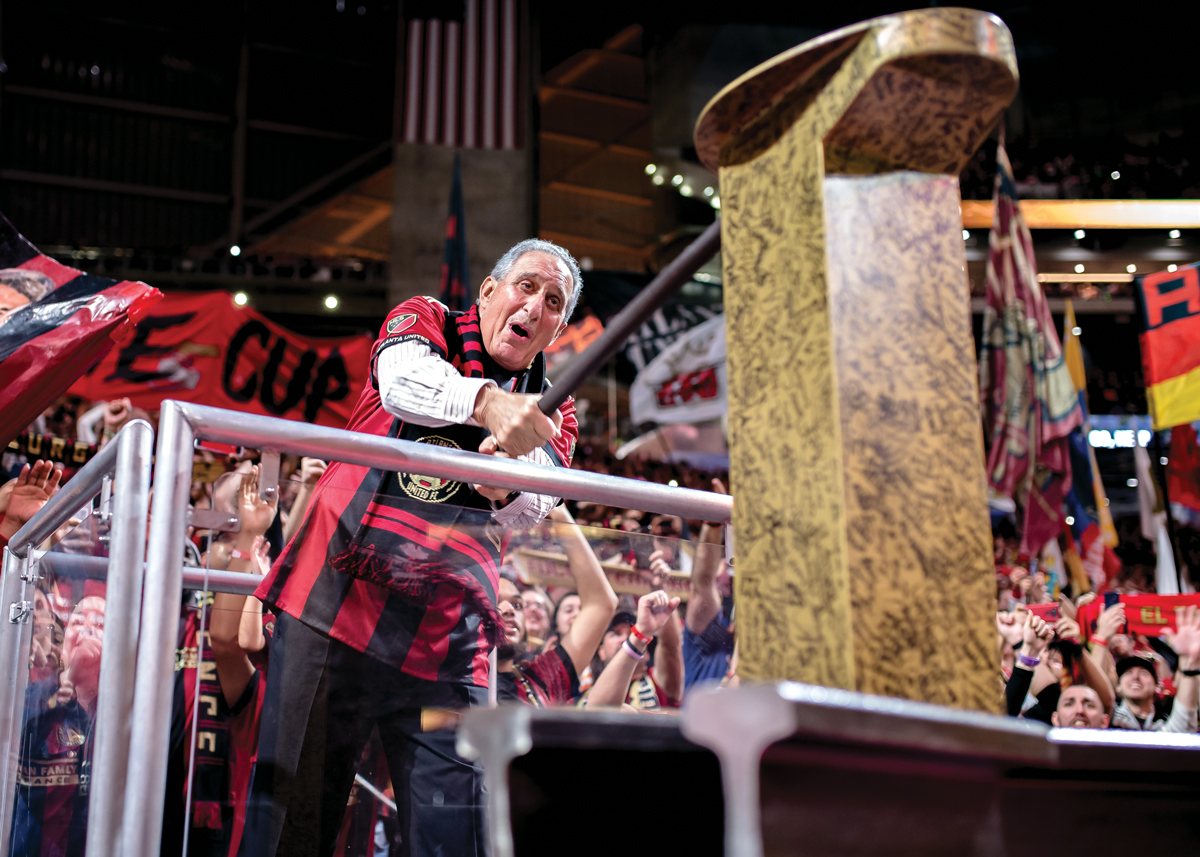
Arthur Blank (see Uncle Arthur) pounds in the Golden Spike.
We assume the hammer is from the Home Depot.
Golden Spike
A nod to Atlanta’s history as a railroad town, the Golden Spike is an eight-foot-long replica that is ceremoniously carried into each home match before a special guest hammers it home.
Griggs, Catie
Atlanta United’s vice president of business operations and a key voice in determining the price of tickets and if all of Mercedes-Benz Stadium will be open for a given game. The team can configure the stadium in two ways: It can curtain off the top deck, reducing the capacity to around 45,000; or, it can open up the entire house, allowing as many as 73,000 fans into the building. As Griggs explains, it’s important that, no matter which option the front office chooses, every visible seat be filled. That’s why the team is in no hurry to open the top deck for every game. “We don’t want to let the air out of the balloon,” Griggs says. Sure, even if the team sold an extra 20,000 tickets for a game, that would still result in 8,000 or so empty seats. Plus, a glut of availability would reduce the value—actual and perceived—of the lower-bowl seats bought by the season ticketholders. Speaking of whom, the front office is cagey about how many season ticketholders there are, but Griggs says that they renewed at a rate of 95 percent this past year. What does that mean for the 10,000-plus on the waitlist? They should get comfortable. Finally, regarding pricing, Griggs says the franchise looks at a number of factors—MLS averages, demand, and how much tickets are fetching on the secondary market. (Incidentally, Griggs says the front office has cancelled the accounts of some season ticketholders who were buying their tickets simply to resell them. How do officials know? Tickets are mobile-only, so the team can track how often they’re transferred.) But Griggs says that founding members—the 25,000-plus who signed up for season tickets before the inaugural season—will always get the best deal. “That’s a hard line in the sand for us.”
Guzan, BRAD (See Polar Bear)
Homegrown
As its name suggests, Homegrown Players refer to players brought up proximate to an MLS franchise. With competition fierce to spot the next George Bello or Andrew Carleton, MLS assigns a “territory” to each team—essentially a protected geographic area that gives the team exclusive rights to sign a player from that region. That’s great for a team, since it’s like erecting a wall around its talent pool. However, it’s not always great for a player, if, say, they’re bypassed by their home team but might be of interest to another team. MLS is reportedly considering eliminating the territories.
Independiente
Argentine football club where midfielder Ezequiel Barco got his professional start. Atlanta United reportedly paid Independiente $15 million for Barco, a record MLS transfer fee.
Juventus
An Italian soccer club, competing in the Serie A league, that faced off against the MLS All-Stars at Mercedes-Benz Stadium last August. Juventus’s most famous player is legend Cristiano Ronaldo, who unfortunately was off somewhere counting his money and couldn’t play.
Karaoke
A rite of passage for new Atlanta United players and employees. As team president Darren Eales explains it, the tradition began on a recon trip to Portland before Atlanta United’s inaugural season. Eales and four other team officials, including technical director Carlos Bocanegra, ended up at a karaoke bar. At one point, Bocanegra was singing “You’ve Lost that Lovin’ Feeling” while a few members of the audience, who happened to be in the Navy, joined in, a la Top Gun. Incidentally, Tata Martino had to sing “Head, Shoulders, Knees, and Toes,” in part to help him with his English. These days, Eales says, karaoke bar visits happen quarterly as a kind of franchise on-boarding. Of course, Eales is duty-bound to start things off. He always picks “Karma Chameleon.”
LGP
Shorthand for Leonardo González Pirez, a linchpin of Atlanta’s defense and the unofficial welcomer to new players on the team, especially those from South America. LGP loves to golf, but he has a ways to go before he’s as good as teammate Julian Gressel, who told the AJC last fall that he shot 69 at East Lake Golf Club.
magic city
Atlanta’s most famous strip club and a destination for at least some of the Atlanta United team after winning the MLS Cup. (And yes, they brought the cup, into which, presumably, it was made to rain.)
march to the match
A game-day ritual that currently originates in the Gulch after several hours of pregame lubrication. Commencing around 90 minutes before game time, the march features several hundred fans making their way to Mercedes-Benz Stadium.
MARTÍNEZ, JOSEf
Valencia, the fourth-largest city in Venezuela, is known for producing baseball players, not soccer players. Josef Martínez was born there 26 years ago and took up soccer because it was the only sport his grandfather, who raised him, watched. In an essay he wrote for the Players’ Tribune last November, Martínez recalled as a child debating whether to spend his money on dinner or on bus fare home from soccer practice. If he chose dinner, he’d face a three-hour walk home. “This environment,” he wrote, “raises fighters.” When Darren Eales and Tata Martino were building Atlanta United from the ground up and they called Martínez, the young man didn’t even know where Atlanta was. But he knew of Martino. And he knew he wanted out of Italy, where he’d been playing and where he’d been increasingly maligned by a fickle fan base. In Atlanta, Martínez has found familia. He has also, not coincidentally, found preposterous success. Going into the playoffs last year, he’d already scored 31 goals, more in one season than any MLS player before him. Martínez is a striker, so he doesn’t clock the same mileage in a game that, say, a wide-ranging midfielder does. Even still, Martínez can seem almost laconic when the ball is not around him, like a daydreaming outfielder in sandlot baseball. On July 4 in Dallas last year, as teammate Tito Villalba (see also Villalba, Tito) was serpentining toward the Dallas keeper, Martínez was standing 30 feet outside the penalty box, bending down, appearing to adjust his socks. That was one second. Three seconds later he was sliding into Villalba’s cross for his 16th goal of the season. In the MLS Cup against Portland, with no score in the 41st minute, Martínez found himself with the ball, one-on-one against the goalkeeper. In the span of two seconds, he modulated his footspeed at least four times, throwing the keeper into hopeless confusion before the ball skidded into the net. When he accepted the league MVP award last December, before signing a contract extension that will keep him here through 2023, Martínez said, “I hope to bring joy to this city that needs and dreams of it.”
MARTÍNEZ, pity
A player signed primarily because of the vast potential his name provides to tifo-makers (see also Tifos). To wit: I pity the fool. More’s the pity. For pity’s sake. Okay, also because last year he was named the best soccer player in South America and helped lead his team at the time, Argentina’s River Plate, to the Copa Libertadores championship. Pity’s real first name is Gonzalo, but he’ll answer to that only if you’re his mother, who gave him the nickname Pity (pronounced PEE-tee) when he was a child, thanks to his energetic resemblance to the pititorra, a flitting sparrow. Pity’s arrival has given Atlanta United an embarrassment of riches, talent-wise, and evoked the kind of jealousy from other MLS cities once reserved for every Major League Baseball franchise that wasn’t the Yankees. Sorry, Orlando. (See Rivalry, Orlando.)
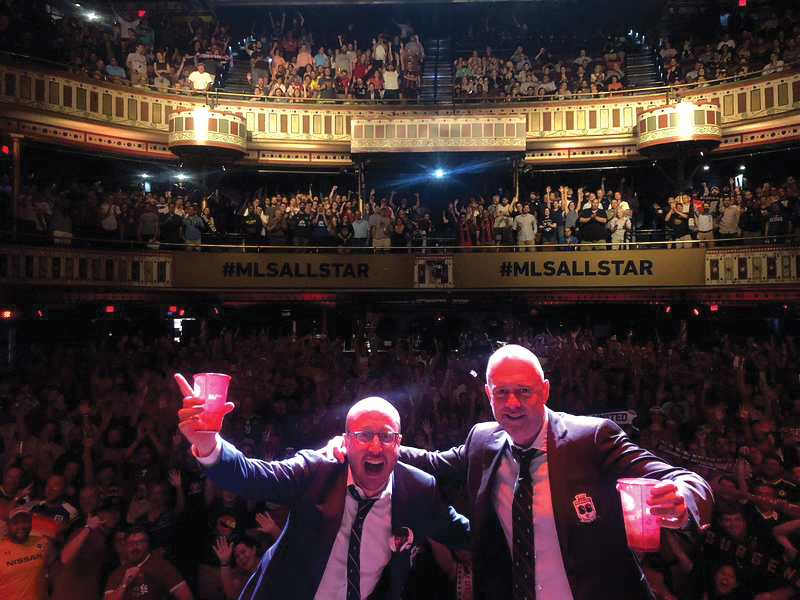
MEN IN BLAZERS
A popular soccer podcast hosted by Michael Davies and Roger Bennett, authoritative yet sardonic ambassadors for the game. Their book, Encyclopedia Blazertannica, inspired the Atlanta United homage you’re reading now. When Atlanta hosted last year’s MLS All-Star game, the podcast was broadcast from a sold-out Tabernacle, where Davies described Atlanta as “American soccer’s new Jerusalem.”
miggy
Nickname for Miguel Almirón, the ever-smiling midfielder acquired by Newcastle after its coach threatened to quit if they didn’t sign him.
“MUCHA PLATA, Y’ALL”
Sign-off of Soccer Down Here, a daily two-hour podcast. In Spanish, plata means gold or riches. The podcast is cohosted by Jason Longshore, Atlanta’s resident soccer expert and evangelizer. Longshore possesses an encyclopedic knowledge of the game’s history in Atlanta, and provides color commentary for 92.9 The Game’s match coverage. Longshore is identifiable by his newsboy cap, which he wears since suffering a concussion that left him sensitive to bright light.
NEWELL’S OLD BOYS
One of the premier football clubs in Argentina, its name harks back to the days of British colonialism. England native Isaac Newell cultivated the game in Argentina in the 19th century; Isaac’s son, Claudio, founded the club in 1903. “Old boys” is a Briticism for graduates. Among Newell’s most famous former players are Lionel Messi and Tata Martino, who was Atlanta United’s first head coach (and who also coached Newell’s). One of Atlanta United’s starting defenders, at least until he broke his right collarbone during training in January, is Franco Escobar, whose career began at Newell’s. Want to impress your soccer pals? Refer to Newell’s as “leprosos,” a nickname they got after a charity match benefiting lepers a century ago.
Open the Roof
A reference to the retractable roof at Mercedes-Benz Stadium. Since the roof—whose complex oculus-like opening has been a mechanical challenge—was automated, the team has played just a handful of games with it open. With most home games played during the warm months, fans will secretly tell you they prefer the roof closed.
Opta
One of several companies that provides data on player performance, used in part by scouting operations at MLS clubs. Carlos Bocanegra, Atlanta United’s technical director, says statistics are one tool, but soccer doesn’t lend itself to the kind of intensive data analysis you’ll find with Sabermetrics in baseball. “Soccer is so dynamic,” he says. “You have patterns of play, but when the ball moves, the situation changes every second. So it’s hard to quantify that from data.” Offense is easier to quantify—passing accuracy, goals, assists, etc. Bocanegra does use data to explore the movement of players on the field. “The heat maps show where the players like to be on the field, and what their passing thought process is, and what combinations they use. I like that for when we’re putting together partnerships on the field, because these two moving patterns can complement each other.” Here’s some trivia: American Soccer Analysis has found that, while most MLS clubs take shots closer to goal while at home, Atlanta United is actually the reverse; the Five Stripes take shots farther from goal for home games than for away games.
POLAR BEAR
Nickname for Atlanta United goalkeeper Brad Guzan, given to him by teammates Jay DeMerit and Steve Cherundolo from the 2010 U.S. Men’s National Team. Why? “Probably from the fact that I’m kinda pasty, kinda white,” Guzan has said. “I don’t do too well in the sun.” There’s also his size—6-foot-4, 209 pounds. The legend of the Polar Bear only intensifies when he plays in the snow. Through Guzan’s professional career, he’s also been called “El Gusano” (Spanish for worm, but this was a term of endearment), Gru, and Mr. Clean Sheet (a reference not to a victory over nighttime incontinence, but rather when a keeper prevents an opposing team from scoring. Also, Guzan bears a passing resemblance to Mr. Clean).
Quiz
Select a name and match it with the correct answer!

Rivalry, Orlando
Can a team you’ve never lost to really be a rival? In the two seasons of its existence, Atlanta United has beaten Orlando City Soccer Club four times, tied twice, and lost precisely zero times. Turns out this is more a feud between a handful of fans than between teams. It started in 2015—a year before the first Atlanta United player was signed, before the team even had a logo—when supporters group Terminus Legion took a road trip to Charleston for the Carolina Challenge Cup. There, they encountered the Iron Lion Firm, an Orlando supporters group, which led to words, which led to a tussle, which led to Iron Lion members trashing TL’s tailgate and causing $1,500 in damage, including ruined banners and broken pint glasses, according to TL Capo Michael Collier. In photos, gloating ILF culprits can be seen displaying a Terminus Legion banner like a trophy. The following year, Atlanta United front office execs placed their scarf over ILF’s on Sporting Kansas City’s wall of scarves. Then, in 2017, Atlanta United taunted the Lions with a billboard (“Orlando, we’re coming to conquer”) in downtown Orlando. OCSC fans retaliated with the infamous Walking Dead tifo, featuring a homicidal Negan (in a purple scarf) holding a barbed-wired bat over three players and a member of Terminus Legion. (We won that game.) A week later, in Atlanta for a rematch, three Orlando fans were arrested for destroying some metal bleachers after the game ended in a draw. Another game saw trash thrown on the field, which led to a temporary ban on supporters groups from the away city. So, does all this make a rivalry? True football rivalries are epochal, clashes not just of teams but of cultures and classes—think Boca Juniors and River Plate, or Al Ahly and Zamalek. These games have also ended, literally, with casualties. On second thought, we’ll take trash on the field and a few broken pint glasses any day.
SALARIES
Among the things that are easier to understand than the rules by which MLS teams pay their players: astrophysics, the popularity of Maroon 5, why Atlanta schools close at the merest hint of snow. Still want to know? First, every team has, technically speaking, the same budget, which in 2018 was $4,035,000. But that’s misleading. For one thing, that budget applies only to the first 20 players on a squad, of which there are usually 30. The salaries of the remaining 10 don’t count against that “cap,” and the salaries there might be as little as $54,500. (For instance, Mikey Ambrose’s total compensation last year was $68,906; Miguel Almiron’s $2.3 million pay was 33 times that amount.) Second, MLS provides each team with what’s called “allocation money,” which can total as much as $1.4 million. Third, a club can augment its allocation budget with an extra $2.8 million. Finally—and this is the big one—three members of each team are considered “designated players,” meaning they can be paid whatever the club can afford, and only the first half-million dollars of their pay will be counted against their cap. (So why are we calling it a cap when there clearly isn’t one? Some questions have no answers.) All told, Atlanta United’s 2018 player payroll was $11.6 million, ranking it ninth in the league.
Scarves
A sartorial show of support, despite the fact that wearing one to a game during the heat of an Atlanta summer demonstrates an almost pathological level of masochism. The tradition goes back more than 100 years, when English fans wanted to keep warm while also showing support for their team.
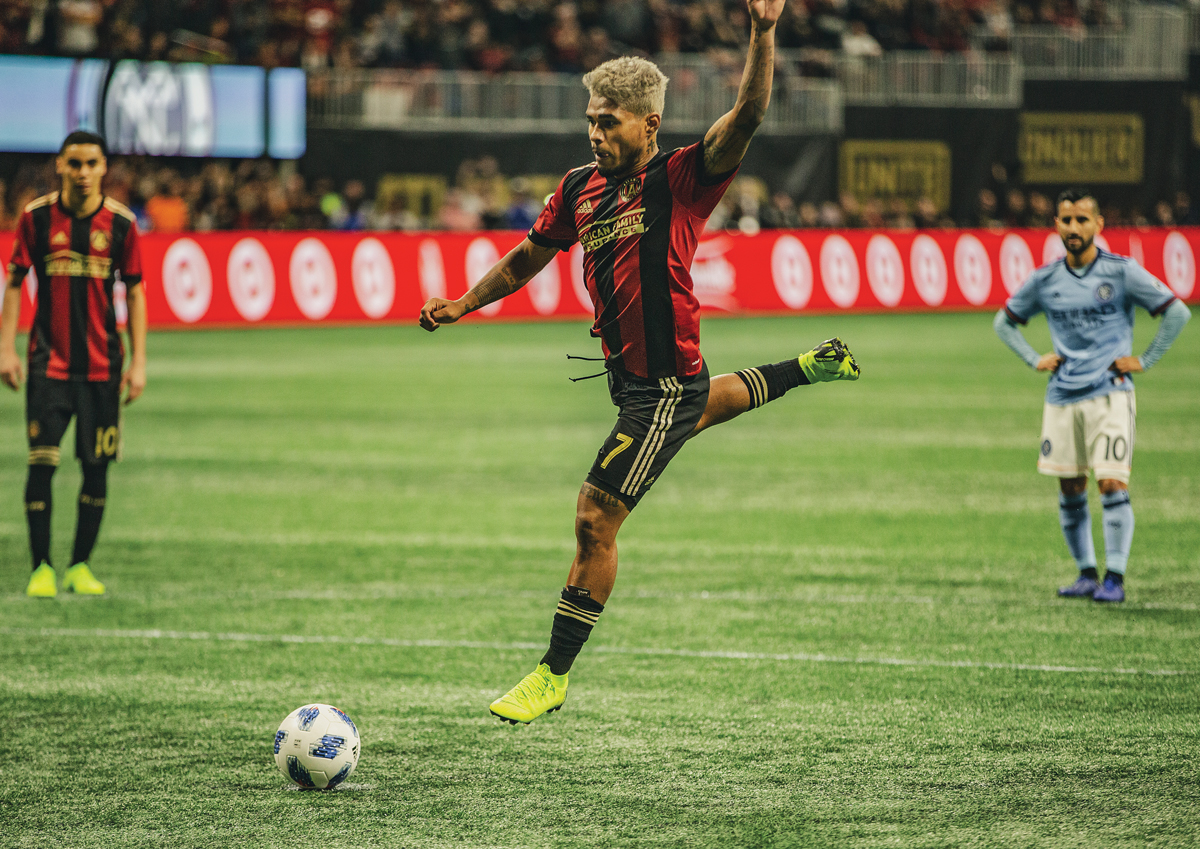
Josef Martínez penalty kick
against NYCFC in the playoffs
Seventeen
Shorthand for Atlanta United’s fan base and a nod to the year of the club’s first season. The number has been retired in honor of the fans, meaning any incoming player can’t wear it. Josef Martínez wore 17 when he played in Italy and loved the number so much he had it tattooed on his neck. But he appears to be doing fine wearing 7 instead. (Incidentally, he reclaimed 17 for the MLS All-Star Game and for Venezuela’s national team.)

StationSoccer
STATIONSOCCER
Currently two MARTA stations—Five Points and West End—boast minipitches where kids play for free and adults can sign up for 5-on-5 games. Nets over the field keep the balls from bouncing onto the tracks. StationSoccer is part of Soccer in the Streets, a nonprofit dedicated to developing young leaders by exposing them to soccer.
SUPPORTERS GROUPS
Go down to the Gulch before a game and it might feel like the first few weeks at college, when everyone seemed to know more people than you did. Thank the supporters groups, essentially social clubs for fans, whose members make up the bulk of the boisterous fan sections within Mercedes-Benz Stadium. The groups have each developed unique reputations and traditions. Want rowdy? Try Resurgence, which describes itself as a “group of lovable assholes.” Want something more family-friendly? Visit Faction. Want a little dirty South? See Footie Mob. Want a bit of everything? Try Terminus Legion. These are just the official supporters groups, sanctioned by Atlanta United’s front office, which means a few things—not the least of which is access to tickets for away games. There are lots more unofficial groups. All Stripes is especially welcoming to LGBTQ fans. In LA 12 de Atlanta, you’ll find Spanish speakers. There’s also Blackharts, Delta 17, and Atlanta’s Army. Most charge around $20 a year, and many offer free or cheap food and beer to members on game days.
tata
Nickname for Gerardo Martino, the legendary Argentine coach and player who was persuaded in 2016 by team president Darren Eales to leave his home and help build a team from scratch in Atlanta, 5,000 miles away. He signed a two-year contract, fittingly winning the MLS Cup in his final game as coach. Martino spoke often about how coaching in Atlanta was a welcome escape from the harsh glare of his soccer-obsessed home country. He’s now the head coach of Mexico’s national team.
Tattoos
What better way to demonstrate your love for your team than to forever emblazon your flesh with its colors? Entire Reddit threads are devoted to discussing what local tattoo artists are best equipped to give you something unique and meaningful. The team itself has highlighted the work of Eddie Stacey, of Roswell’s Ink & Dagger. Stacey, a Founding Member himself and diehard fan, recalled that the phone call from his wife a few years ago telling him we’d landed an MLS team was one of the best calls he ever got—“on the level of when I found out we were having another kid.”
Tickets (See Griggs, Catie)
tifos
Google “tifo” and you’ll find 100 sites saying it’s Italian meaning “support for a team.” Fewer will tell you it can also mean “typhus.” In any case, the phenomenon of tifos—from their conception to construction to display—has become part of the Atlanta United fan DNA in just two years. Consider the one pictured above, designed for the MLS Cup against the Portland Timbers. Made quickly—organizers had just days to plan and execute after Atlanta United advanced in the playoffs a week before—it began with a simple idea: Thomas the Tank Engine, transformed into a barrelling locomotive. “We were letting Portland know, ‘You’re next,’” says Vera Zeigler, a graphic artist and fervent Atlanta United fan who’s become known as the Tifo Queen. Zeigler sketched the outline on the fabric, a crew of painters behind her. The tifo was installed at Mercedes-Benz Stadium the night before the match, attached to the rigging for the field goal net. Tradition dictates that old tifos be burned, but so far that hasn’t happened. Though where they’re kept remains a secret.
TOTAL FOOTBALL
Among the 3,218 reasons that professional soccer has taken generations to catch on in America—“the sport of the future since 1972,” as Men in Blazers puts it—is that the game as it evolved in Europe was so often just . . . boring. Spend 90 minutes watching a match only to see it end in a draw—worst of all a scoreless draw—and you’d be forgiven for switching immediately to a Warriors game. Enter the Dutch. In a philosophy that came to be known as “total football,” Dutch teams such as Ajax (where Atlanta United Coach Frank de Boer played) pioneered a system where players were allowed—and expected—to play outside the boundaries of their traditional positions. So yes, a defender could now score a goal! This strategy meant teams were all about attacking, not just sitting back playing for a draw. They played to win. How very American.
TURF
Last December’s MLS Cup was the first in league history to feature two teams—Atlanta United and Portland Timbers—who play their home games on artificial turf. Most MLS clubs (all but five, in fact) play on grass. When Arthur Blank was first dreaming of a new stadium for his Falcons, he said he wanted grass. But the design he ultimately settled on—with a retractable roof—meant the field couldn’t get enough sun. What’s more, Mercedes-Benz Stadium is a multi-use facility, and a grass field would get pummelled under the weight of concert crowds and monster truck rallies. So we have turf—a surface so loathed by soccer purists that Europe’s Premier League rules actually forbid teams from playing on anything but grass. And though 63 percent of MLS players polled by ESPN said synthetic turf would affect their decision to join a team, it sure doesn’t appear Atlanta United is having any trouble attracting talent. (See Martínez, Pity.) However, if Mercedes-Benz hosts any games during the 2026 World Cup, organizers will have to install grass.
Uncle Arthur
Affectionate shorthand for Arthur Blank, Atlanta United’s owner.* Blank first heard it as a spontaneous chant (“UN-CLE AR-THUR clap clap clapclapclap!”) among fledgling Atlanta United fans when he dropped by a meet-and-greet at a Buckhead bar in the days before the franchise had signed a single player. Blank famously cofounded the Home Depot, making him one of the wealthiest people in the world. Atlanta United’s origins actually trace back to the mid-2000s, when Blank began considering the viability of a professional soccer team in Atlanta. He was coaxed along by his son Joshua, who played for Sandy Springs’s Concorde Fire Soccer Club as a youth. Going to his son’s games (where he met third wife, Angie, mother of one of Josh’s teammates) also allowed Blank to see not only the sport’s popularity but the diversity among its players. “To see these young folks who had come, in many cases, from all over the world, bringing their sport here, was really wonderful for me,” he told MLS.com in 2017. Blank is seen at most Atlanta United home games. (*Technically speaking, Blank is not the owner of Atlanta United, at least not in the way he’s the owner of the Falcons. Rather, per MLS rules, he is considered an “investor-operator.” As the label suggests, he has invested in the league—by paying an expansion fee that allowed him to field a team—and makes operating decisions about who to hire to run it. All the investor-operators must direct 30 percent of their ticket sales to MLS. The league also takes all the revenue from national broadcast rights, all the profits from online merchandise sales, and a cut—as much as 44 percent—of player transfer fees. In exchange, investor-operators get a share of league profits and keep all local broadcast revenues, brick-and-mortar merchandise sales, and, of course, concessions sold at games. What’s more, all player salaries below the cap are paid by the league. The team picks up only the amounts above the cap for designated players. Blank’s investment has clearly paid off; last year, Forbes declared Atlanta United the most valuable franchise in MLS, worth an estimated $330 million. His Falcons are said to be worth $2.6 billion. See also Salaries.)
Unified Team
Part of a league-wide partnership with Special Olympics, the Unified Team is a squad of players—most in their teens and early 20s—with and without intellectual disabilities. During its season, which runs from March to August, the Unified team is outfitted with the same equipment as the first team, practices at the same facility (Children’s Healthcare of Atlanta Training Ground in Marietta), and even hosts its own signing day celebration. Each year, the squad hosts a team from another MLS city and travels for one away game. Best of all, throughout the season, first team players take part in their practices. (This year’s ambassadors to the Unified team are Andrew Carleton, Brad Guzan, and Julian Gressel.) On July 21, if you’re at Mercedes-Benz for the game against D.C. United, stick around afterwards to watch the Unified team take on their counterparts from D.C. “We have spirited, fiery, competitive players,” says Marissa Ahrens, Atlanta United’s manager of community relations.
Villalba, Tito
Owner of the best hair on a team that is already follically blessed, Hector “Tito” Villalba has one of the most compelling backstories on Atlanta United. Raised in an impoverished neighborhood of Buenos Aires, he was plucked at 10 to train at the youth academy of San Lorenzo, one of Argentina’s oldest soccer clubs and the favorite of Pope Francis. In his first start for San Lorenzo at age 18, Villalba sprinted 80 yards, around defenders, to score a goal that some fans compared favorably to Diego Maradona’s Goal of the Century. In 2017, during Atlanta United’s inaugural season, he earned the MLS Goal of the Year with a rocket to the upper corner of the Orlando goal from 30 yards out. More significantly for our purposes, his equalizer in stoppage time against Orlando at Bobby Dodd Stadium that year earned him the nickname “Lion Tamer.”
We Gon’ Shine
One of the marketing slogans utilized by Atlanta United to conjure excitement for the team. Much of the messaging around the team has been the work of Chemistry, an ad agency with offices in Pittsburgh and Atlanta. Chemistry’s campaign for the team has won numerous local and national advertising awards. “Chemistry believes in blowing shit up,” the agency boasts. Alas, when we asked for some time to talk more about what went into the campaign, the company directed us back to Atlanta United’s front office.
XI
Archaic yet durably pretentious way to refer to the starting 11 players in a soccer match. Why Roman numerals and not just 11? For the same reason that it was Super Bowl LIII and not 53. Whatever reason that is.
YERBA MATE
It’s an antidepressant! A stimulant! An appetite suppressant! It’s yerba mate, an herbal tea made from the leaves of a flowering tree in South America. Soccer players from Argentina, Uruguay, and Brazil have been the drink’s greatest ambassadors. Lionel Messi is a fan. Atlanta United players are likely to be seen taking sips during practice.
ZuÑiga, felix
Gainesville barber whose Instagram message to Yamil Asad led to Zuñiga becoming the official barber for much of the first team. Zuñiga told the Gainesville Times that, of all the players, Tito Villalba’s hair is the toughest to cut. Maybe because he’s the pickiest.


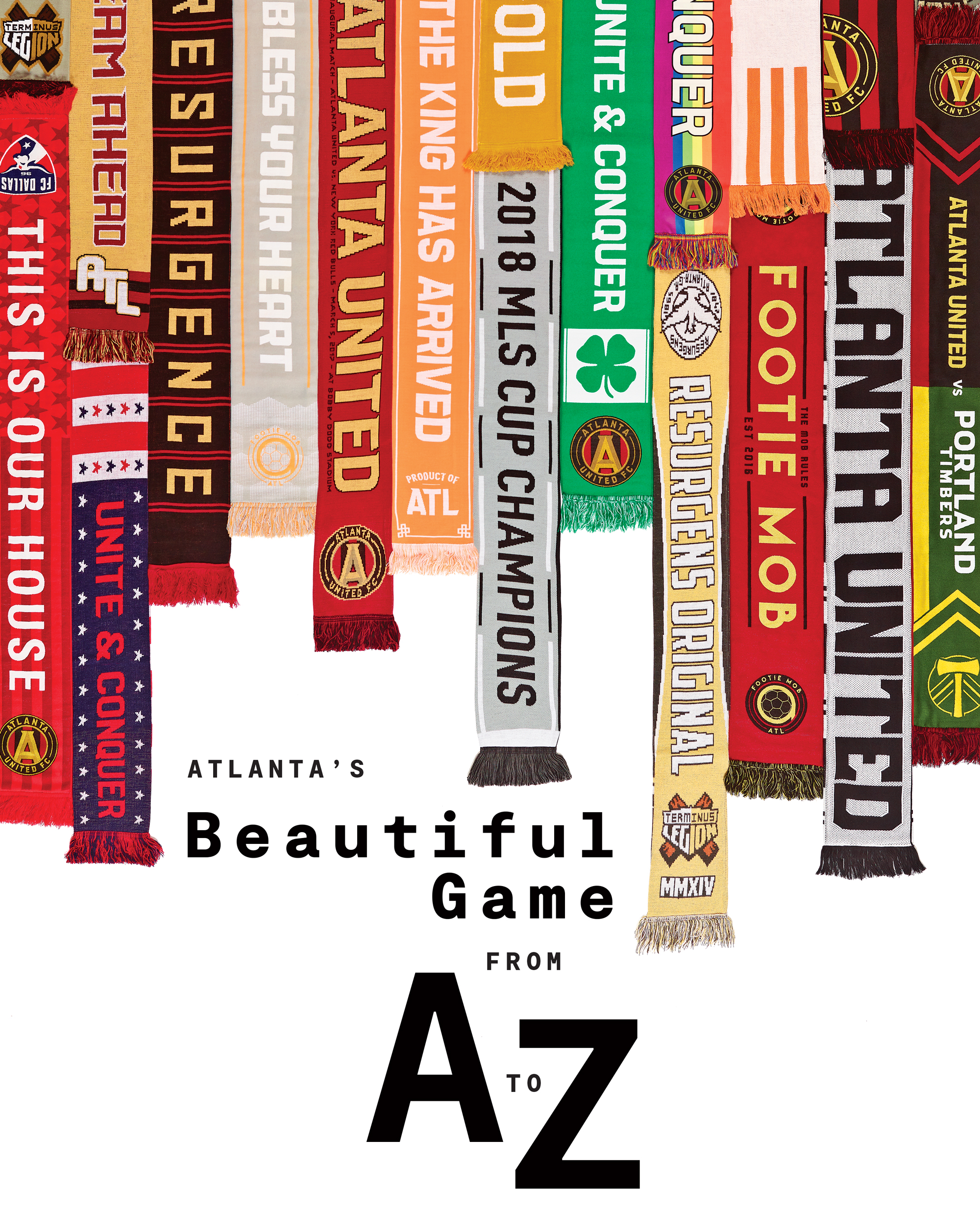



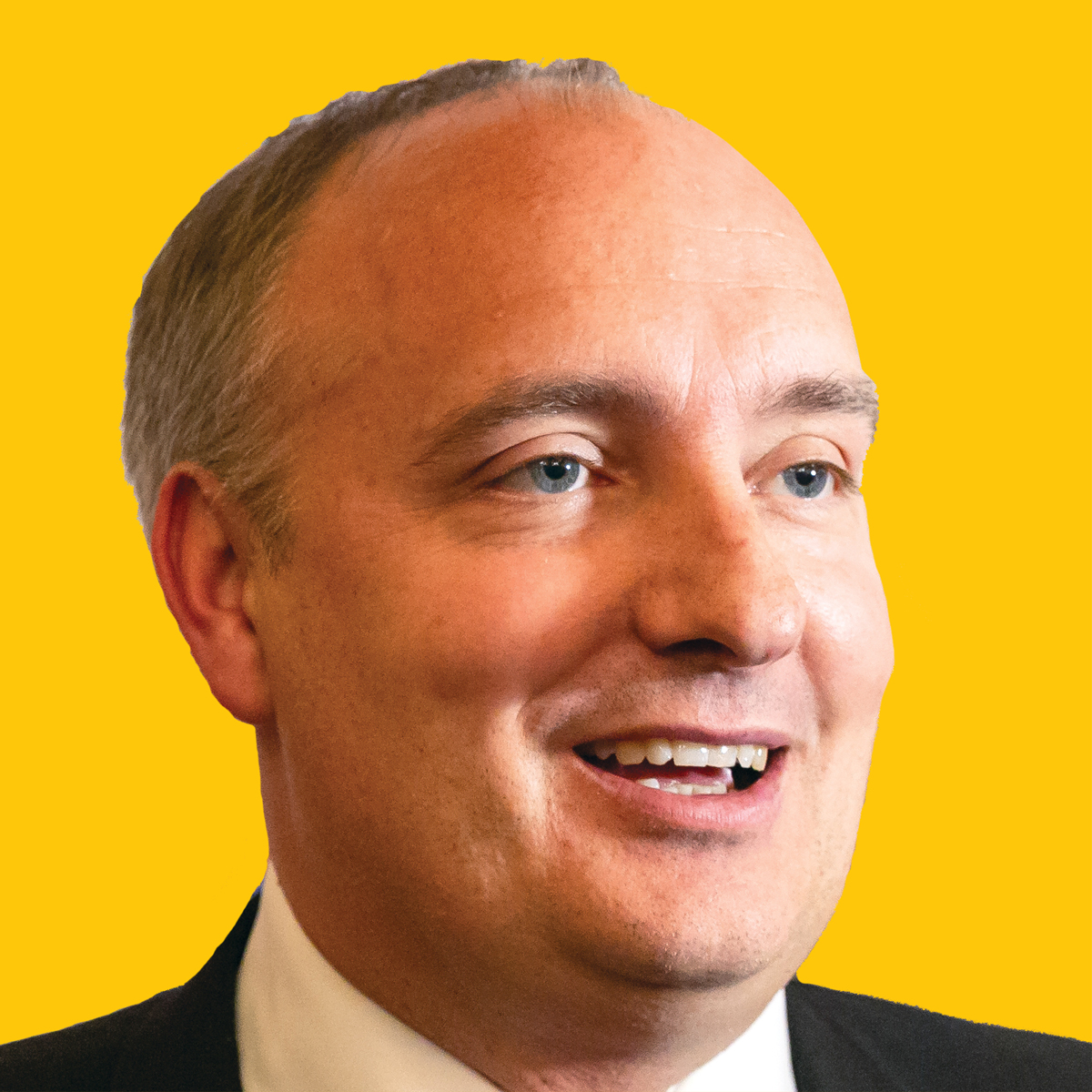
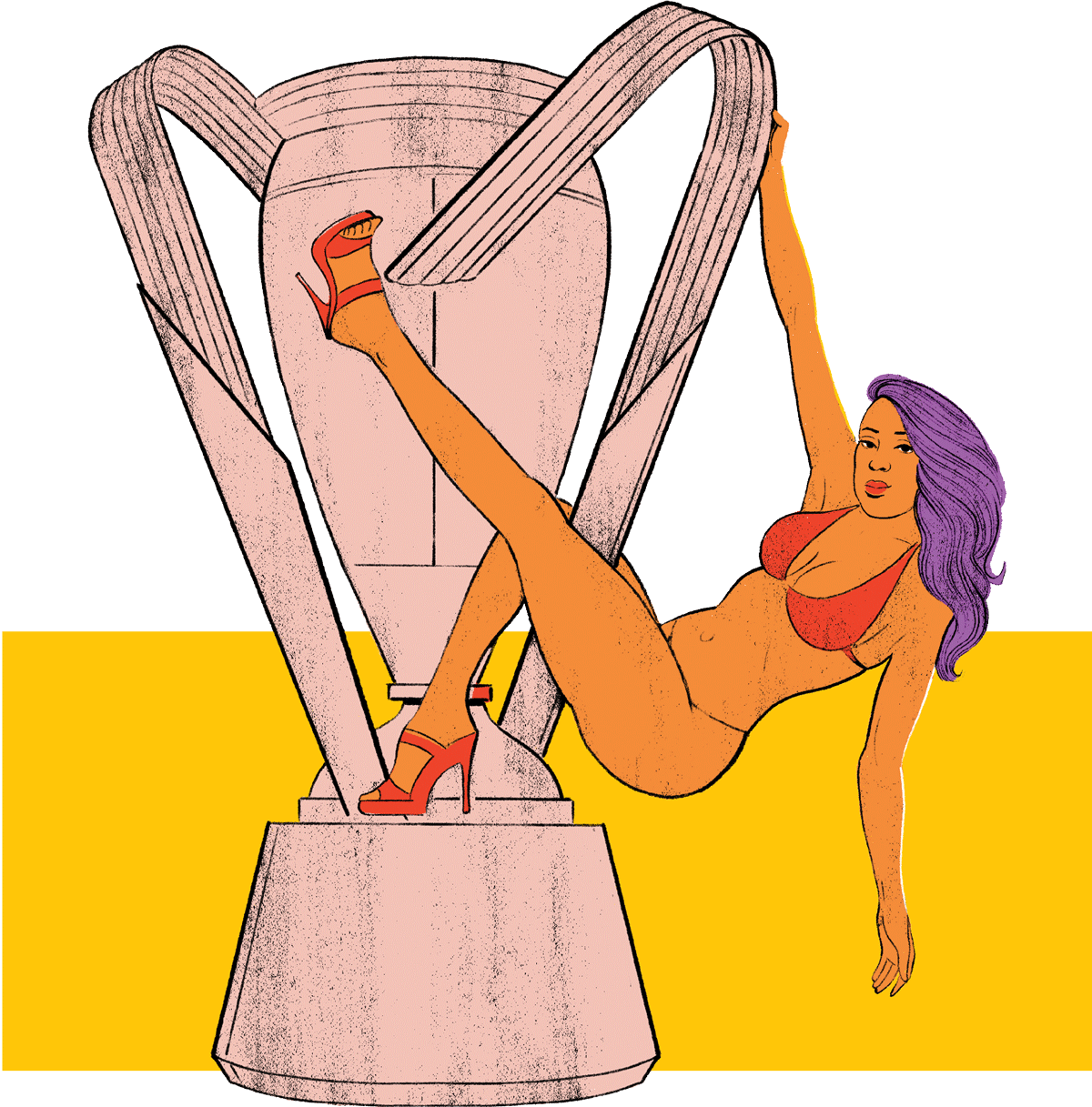



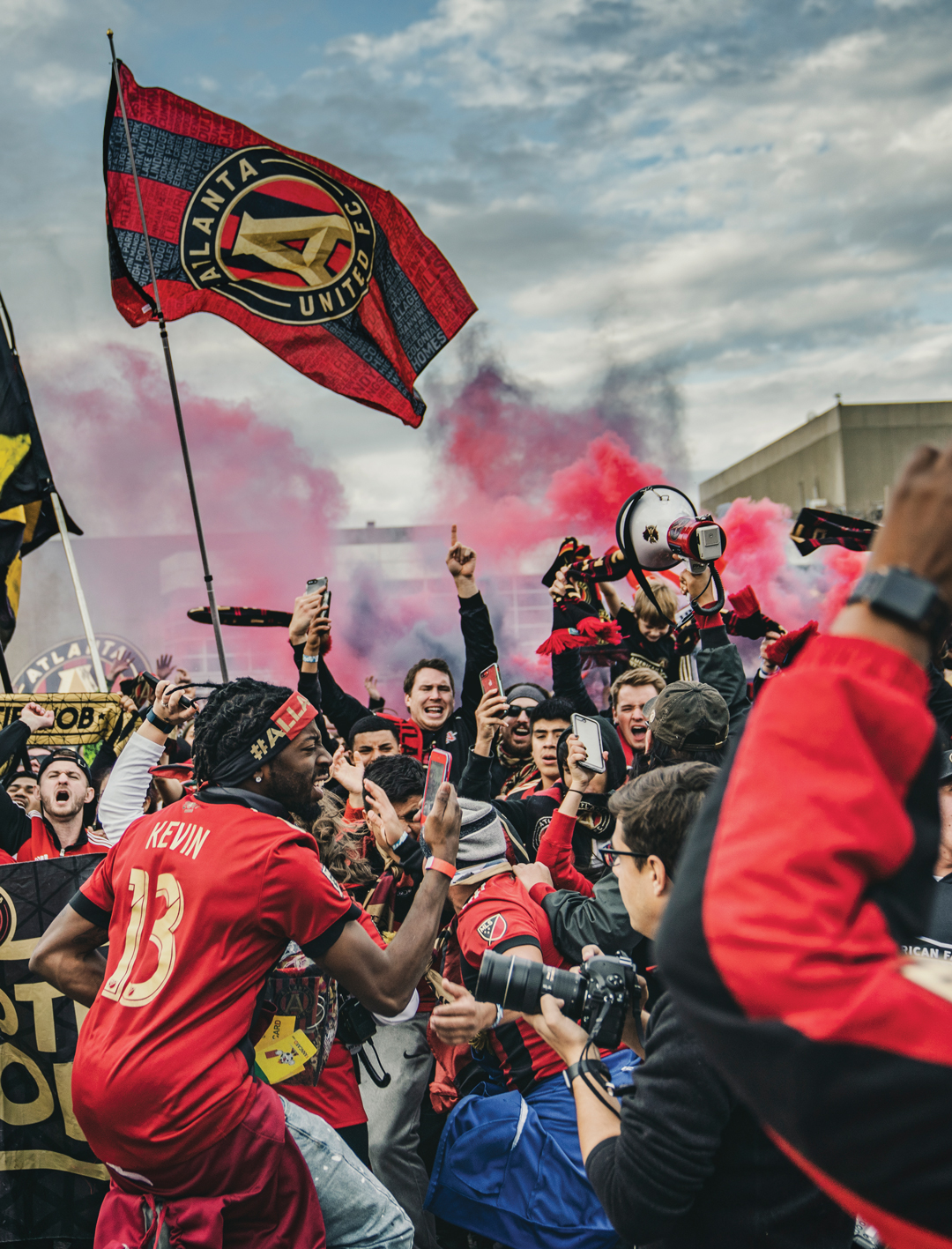


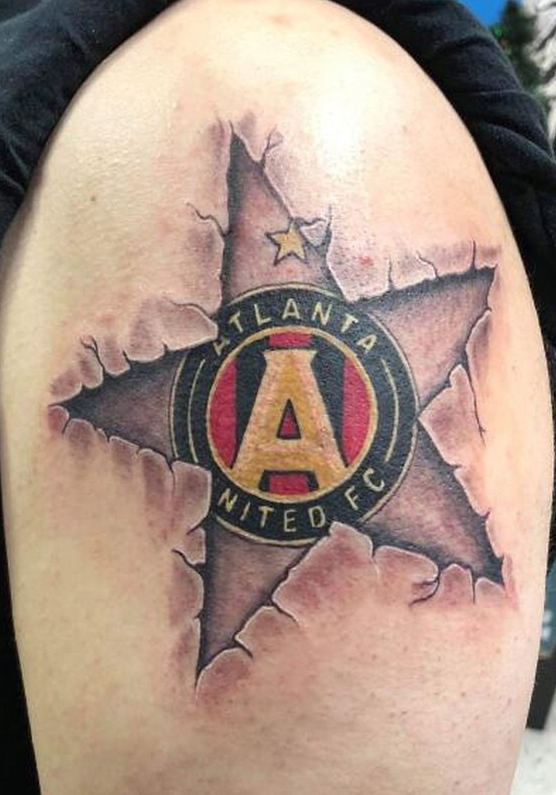
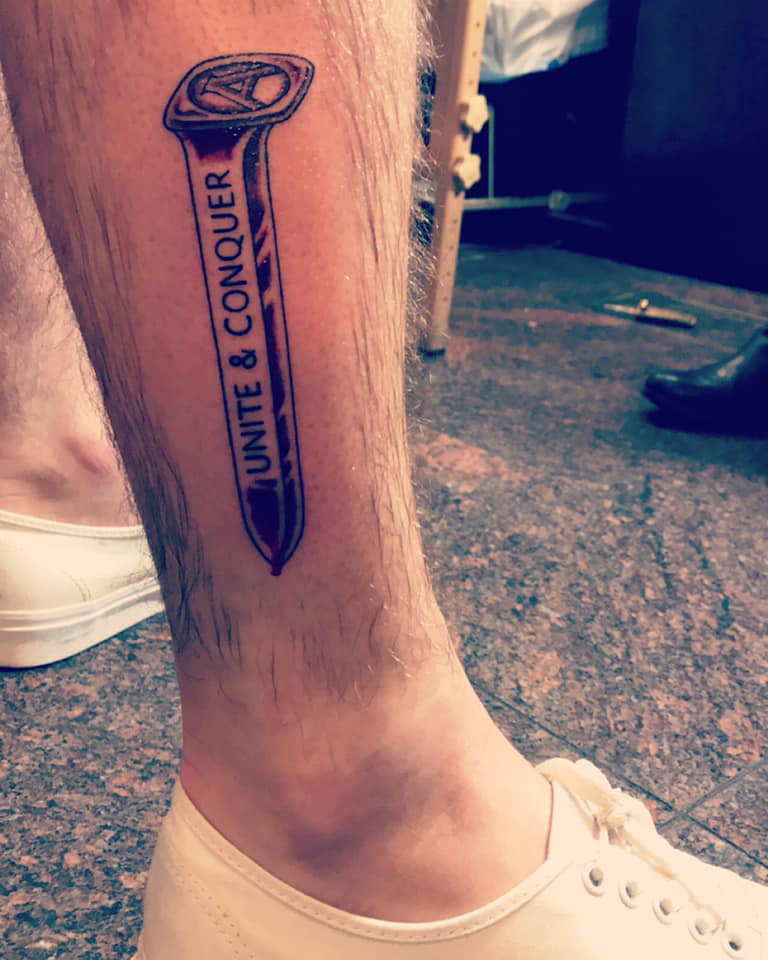




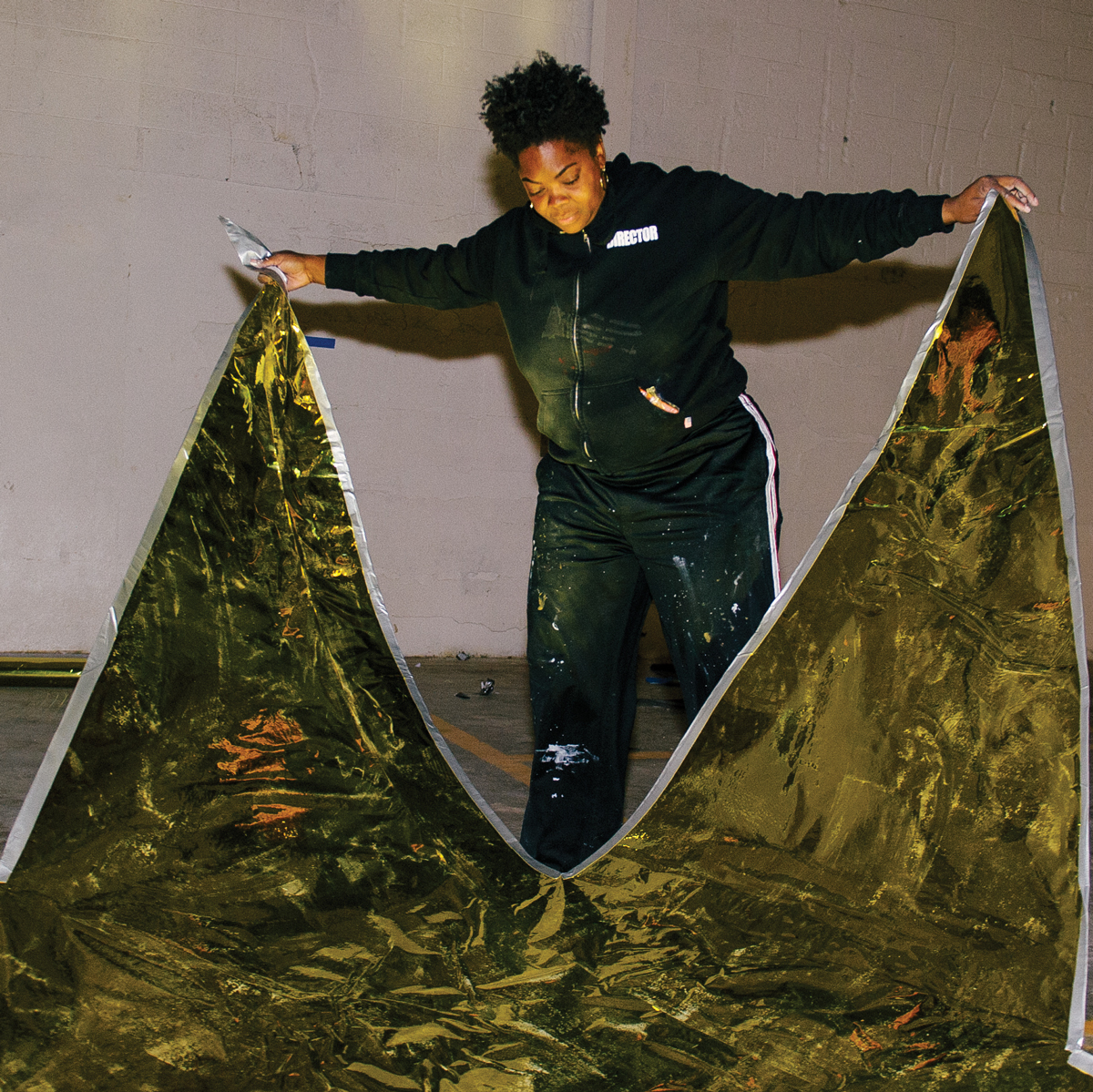
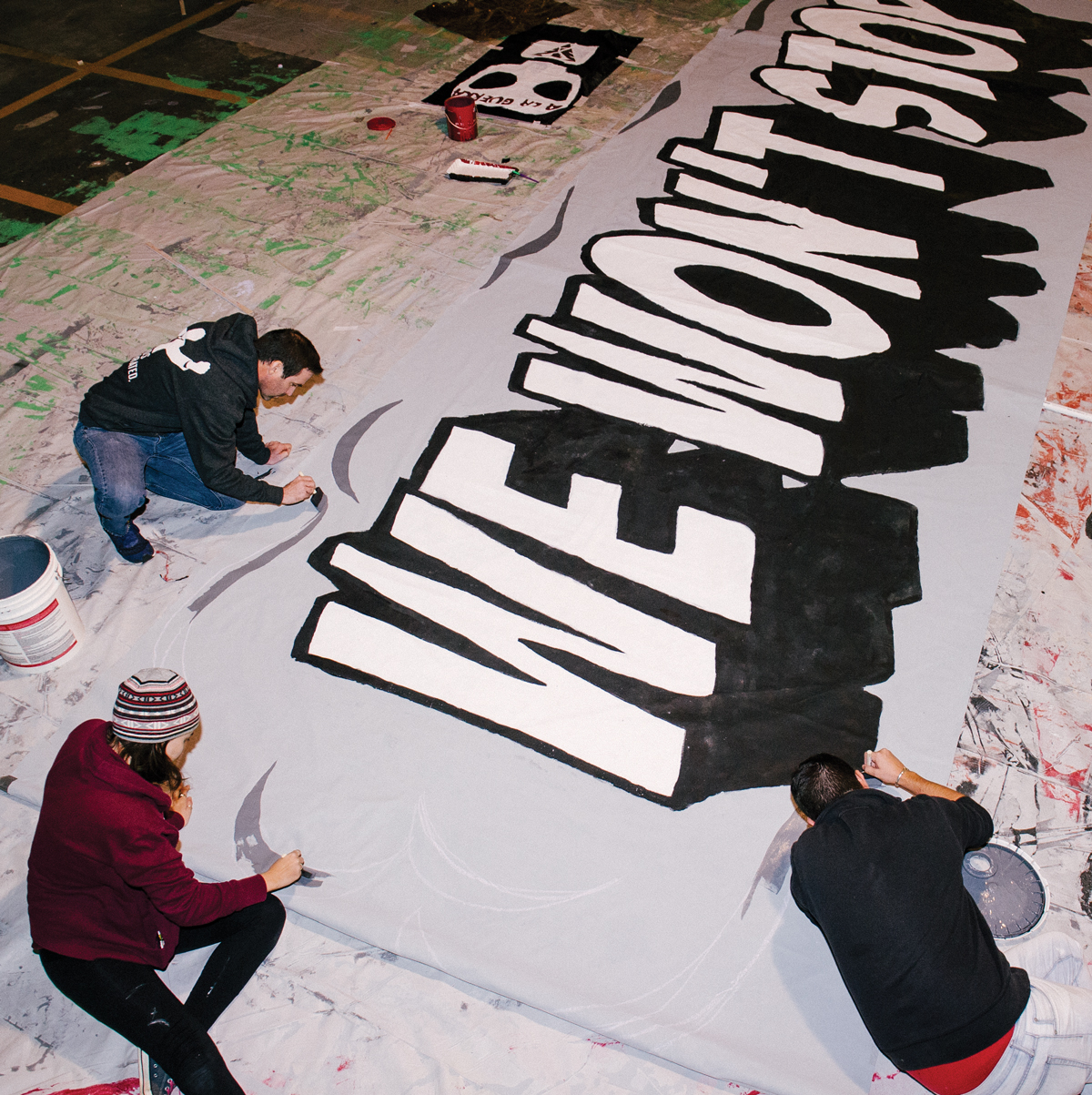


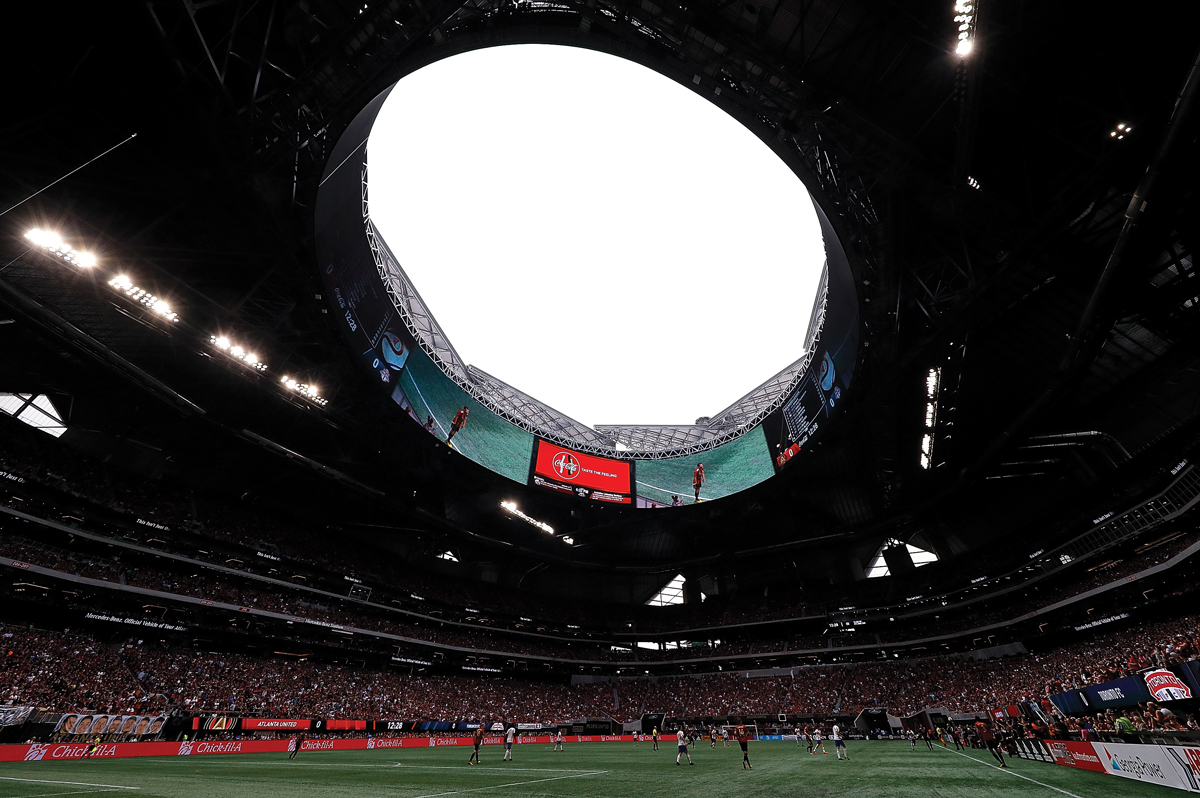


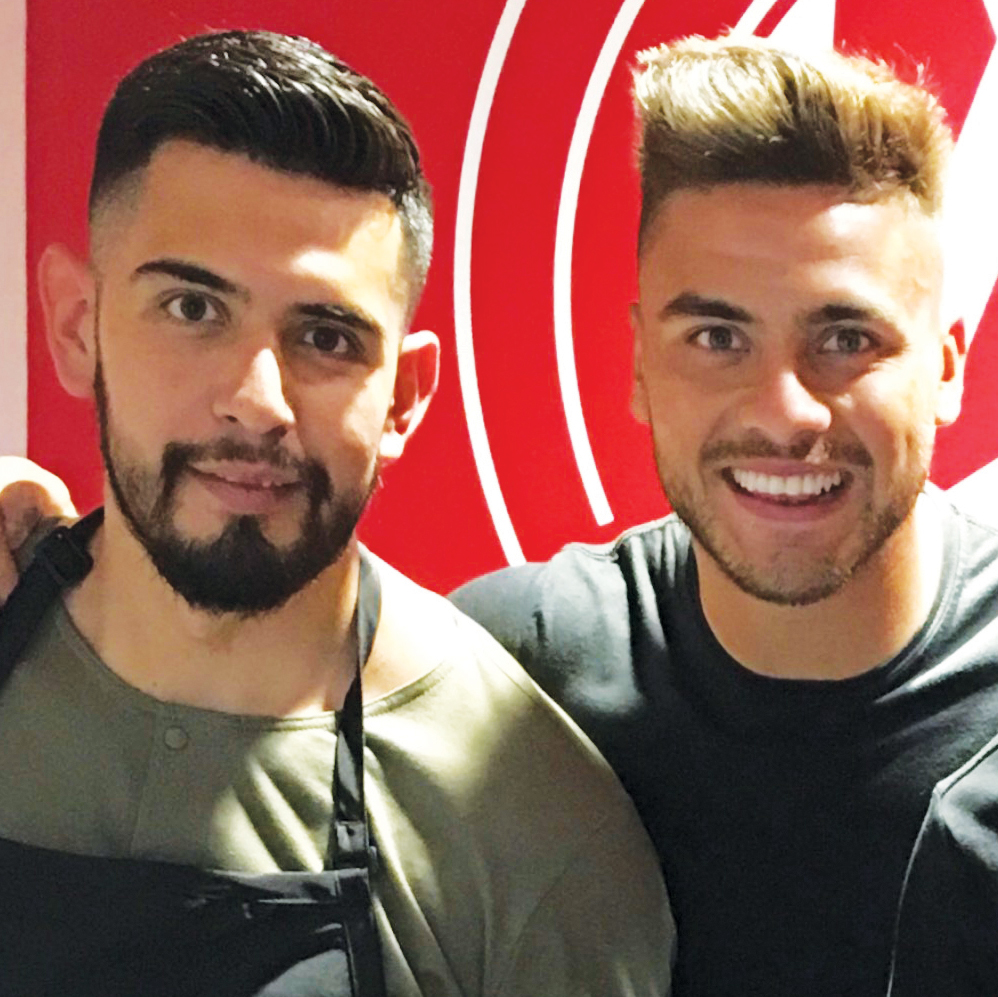


![The North Carolina Museum of Natural Sciences’ newest exhibit is a [pre]historic first](https://cdn2.atlantamagazine.com/wp-content/uploads/sites/4/2024/04/DD-3-100x70.jpg)




